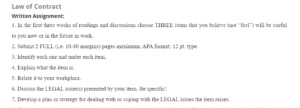Law of Contract
Executive Summary
This paper will discuss three items in the Contract of Law that are useful now and in the future in the workplace. The three items are; Remedies, Parole Evidence Rule, and Good faith versus reasonable. The discussions will include the legal issues presented by these items and strategies for dealing with these legal issues.
Are you interested in an authentic copy of “Law of Contract”? Contact us.
Introduction
Like most legal principles, the fundamentals of the law of contract vary by jurisdiction (Scott, 2003). However, in every jurisdiction, contracts are supposed to have an offer, a subsequent agreement by both parties to the contract’s stipulations, and a consideration. These attributes are vital for a document’s foundation to be considered a valid and legally binding contract. Below are some Contract law items alongside their legal issues and strategies to deal with them.
Remedies
A remedy is identified as the action course available to the aggrieved party in enforcing his right in the case of a breach of contract (FindLaw, 2018). If the latter happens, the aggrieved party will have one of the remedies below against the guilty party. The remedies include; contract rescission, a suit for quantum merit, a suit for damage, a specific performance suit, and an injunction suit. In the case of discrimination in the workplace, the objective is to put the discrimination victim in a similar position he was supposed to be if it were not for the discrimination. The type of remedy depends on the action of discrimination and how it impacts the victim. For instance, if one fails to be selected for a job due to discrimination, the remedy might be a job placement.
Parole Evidence Rule
Generally, the parole evidence rule hinders one from introducing evidence of prior agreement or negotiation that modifies, contradicts, or varies with the terms of the written contract since the contract is supposed to be a final and complete expression of the agreement of the parties (JUDICIAL EDUCATION CENTER, 2018). A merger clause strengthens the written presumption in the document stating that it is final and complete as per the parties’ agreement. Hence, even if the parties had an additional agreement that does not appear in or contradicts the original contract, the court will not enforce the different or additional terms.
Suppose the boss fails to pay the employees’ salaries on the agreed date on the contract signed and executed by both the employees and the employer. The employees take the employer to court for failing to pay them as agreed and ask for additional bonuses for the delay. In that case, the court will likely grant employees the salaries stipulated in the contract since the agreement doesn’t mention any bonuses in case of delays. Any evidence of penalty on delays is parole evidence, and the court will have to enforce only the precise contract terms. A strategy for the above legal issue is to have subsequent contract modification.
Good Faith versus Reasonable
In the law of contract, the implied agreement of fair dealing and good faith is an overall assumption that the contractual parties will deal with one another fairly, honestly, and in good faith to avoid destroying the parties’ rights to receive the contract’s benefits. Reasonableness, on the other hand, is an objective aspect that raises the question of how a reasonable person would have acted in a certain circumstance. In the workplace, an employment contract contains an unspoken agreement of fair dealing and good faith. It means that both the employer and the employee owe a duty to each other to deal fairly with one another and act in good faith. On the other hand, the legal meaning of being reasonable is not straightforward, and the appropriate way is to judge it according to how other people would have reacted in the same situation.
Conclusion
In conclusion, the above three items of contract law tend to explain the basics of contract law and how it can be applied in the workplace. Both the employer and the employee should take heed of the contract law and what to expect in certain circumstances as far as the law is concerned.
Similar Post: Create a Budget and Financial Plan for a Vacation Trip
References
FindLaw. (2018). What Is the Most Common Legal Remedy for a Breach of Contract? Retrieved from https://smallbusiness.findlaw.com/business-contracts-forms/what-is-the-most-common-legal-remedy-for-breach-of-contract.html
JUDICIAL EDUCATION CENTER. (2018). The Parol Evidence Rule. Retrieved from unm.edu: http://jec.unm.edu/education/online-training/contract-law-tutorial/the-parol-evidence-rule
Scott, R. E. (2003). Contract Theory and the Limits of Contract Law. Retrieved from yale.edu: https://digitalcommons.law.yale.edu/cgi/viewcontent.cgi?referer=https://www.google.com/&httpsredir=1&article=1307&context=fss_papers
ORDER A PLAGIARISM-FREE PAPER HERE
We’ll write everything from scratch
Question
Law of Contract
Written Assignment:
- In the first three weeks of readings and discussions, choose THREE items that you believe (not “feel”) will be useful to you now or in the future in work.
- Submit 2 FULL (i.e., 10-80 margins) pages maximum; APA format; 12 pt. type.
Law of Contract
- Identify each one, and under each item,
- Explain what the item is.
- Relate it to your workplace.
- Discuss the LEGAL issue(s) presented by your item. Be specific!
- Develop a plan or strategy for dealing with or coping with the LEGAL issues the item raises.
- Refer to the written assignment rubric in your classroom for guidelines (APA) and expectations that will be used to evaluate your work.
If Three items need to be selected, I chose 1 Remedy 2 Parol Evidence Rule 3 Good faith vs. reasonable.


